|
|
If you are reading these rules for the first time, ignore the text along the right hand side. These rules serve as a summary to help you quickly familiarize yourself with the game.
Show
→ summary only
→ detailed version only
→ both summary and detailed version
In the game BILLABONG, up to twenty kangaroos have a jumping race
around a small lake - that is, the "Billabong". Each player leads
a team of 5 kangaroos as a kind of kangaroo "trainer".
The objective is to be the first to guide all of your kangaroos clockwise
around the "Billabong" and across the start-finish line. The "Billabong" is
the small 2 x 4 space lake in the centre of the gameboard, and the little
creek flowing into the "Billabong" is considered the start-finish line.
To make sure that everything runs smoothly during the big jumping race,
there is a "referee kangaroo". This is of course the black kangaroo figure.
Game Materials
-
1 large gameboard
-
5 kangaroo figures in each of 4 colours
-
1 black "referee kangaroo" figure
Set-up
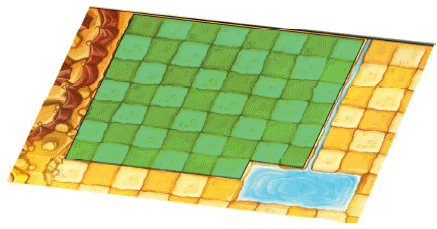
The game board is placed in the middle of the table.
Each player receives the five kangaroo figures of one colour. The black
"referee kangaroo" is placed in the "Billabong". The starting player can
be determined in any way.
In turn, each player places one of their kangaroos, one at a time,
on any unoccupied space behind the start-finish line (see the area
marked in green in the illustration).
Kangaroo Movement
Once the players have placed all their kangaroos on the board, the actual game
begins with the first player who placed one of his kangaroos.
In turn, each player moves one of their kangaroos.
For this, there are two options:
Either: The kangaroo WALKS onto an adjacent unoccupied space
(vertically, horizontally or diagonally - like a chess king). This
ends the player's turn.
Or: The kangaroo JUMPS (vertically, horizontally or diagonally)
over another kangaroo of any colour.
To do this, the other kangaroo must stand in the same line (vertically,
horizontally or diagonally) as the jumping kangaroo. The jumping kangaroo
must be able to land at the same distance beyond the other kangaroo
as from his starting place to that kangaroo (see illustration).
Note: the longest possible single jump is 14 spaces.
In addition, the following rules apply: The
kangaroo may not
- jump over more than one kangaroo
- land on another kangaroo; the landing space always needs to be empty
- jump beyond the edge of the game board
- jump over the "Billabong"
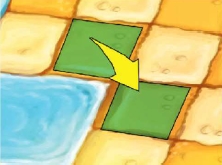 Jumping over a corner of the "Billabong", however, is allowed (see illustration).
Jumping over a corner of the "Billabong", however, is allowed (see illustration).
A kangaroo can make any number of consecutive jumps on one turn!
With each of these jumps, the kangaroo has to jump over exactly one other
kangaroo and then land on a space that is exactly the same distance from
the jumped-over kangaroo as was the starting space of the jump.
It doesn't matter who owns the jumped-over kangaroo; they can be
owned by the jumping player as well as the opponents. Even the black "referee
kangaroo" can be jumped over (see more details below).
IMPORTANT: The possibility of a chain move applies only to JUMPS!
A walking kangaroo always moves only one space, and combinations
of the two move types are not allowed either.
Forbidden Jumps
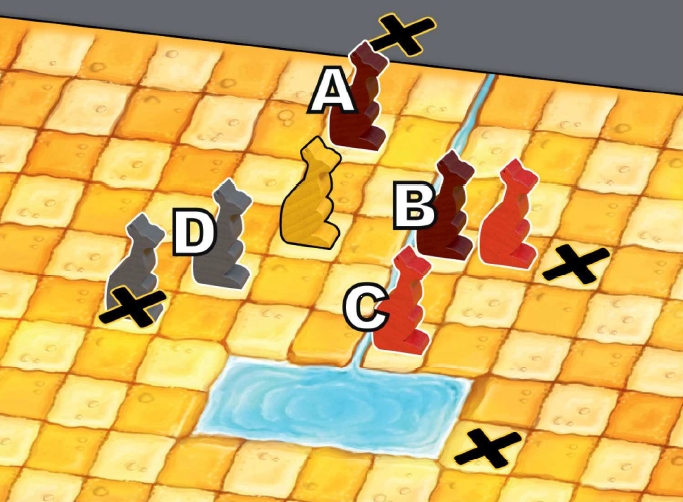
The yellow kangaroo may not jump over the other kangaroo because it would
- leave the game board
- jump over more than one kangaroo
- jump over a part of the "Billabong"
- land on an occupied space
The "referee kangaroo"

One of the most exciting moments during the BILLABONG game is when you figure
out a chain jump that moves a kangaroo particularly far.
Such a series of jumps can consist of a whole lot of individual jumps,
sometimes even multiple jumps over the same kangaroos!
Mistakes can easily happen during the execution of such a chaining move,
which is why there is the black "referee kangaroo".
At the beginning of each chain jump, the "referee kangaroo" is placed
on the starting space of the jumping kangaroo. If things get muddled
up at some point during the execution of the move, you just need to
put the kangaroo back on its starting space (that's where the "referee"
is) and try the move again.
But if you realize that - due to an oversight - the intended series
of jumps is not possible at all, you have to make a different, legitimate
move with the same kangaroo!
When you have finally completed your series of jumps correctly, the
"referee kangaroo" is placed back into the "Billabong", where it will
wait for the next player's move.
Besides this, the "referee kangaroo" has another benefit as well:
After all, it is a kangaroo and as such may also be jumped over, of course!
This can sometimes give you unexpected additional
possibilities.
Example of a complete move

In moving the yellow kangaroo for the first time,
it jumps diagonally over the adjacent brown kangaroo.
The black "referee kangaroo" is placed on the starting space
of the yellow kangaroo.
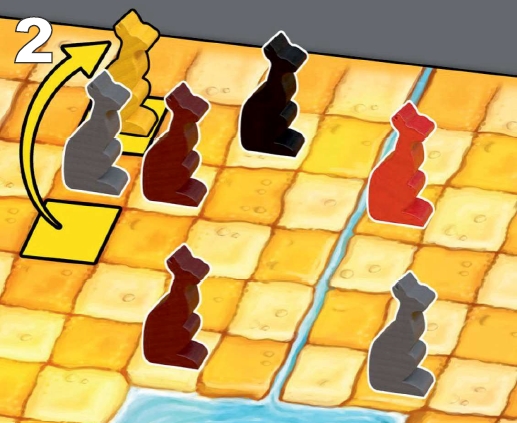
The yellow kangaroo makes another jump, this time over the
grey kangaroo.
With this, it lands two spaces away from its starting space.
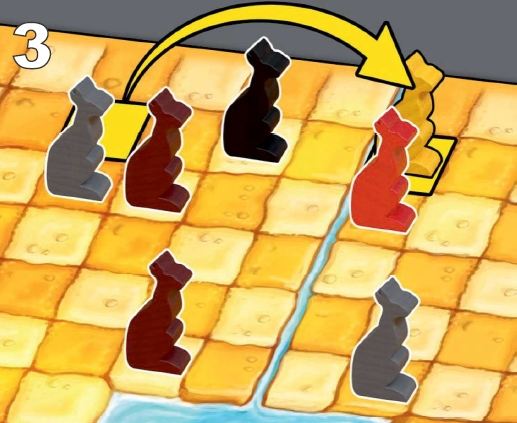
On its third jump, the yellow kangaroo uses the
"referee kangaroo".
This jump is a bit longer because there is one space between the starting field of the jump and the jumped-over (referee) kangaroo.
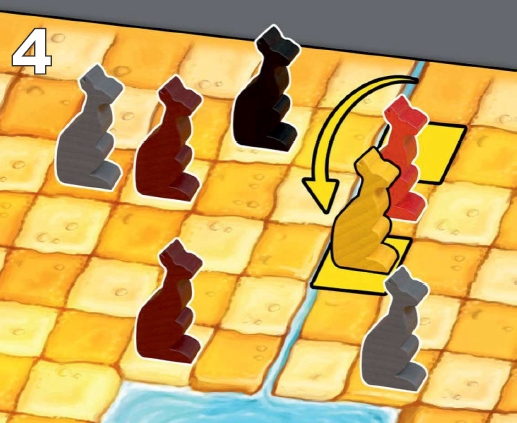
With its fourth jump, the yellow kangaroo ends its turn.
After that, the "referee kangaroo" is put back into the
"Billabong".
Crossing the Finish Line - End of the Game
The "Billabong" must be circumnavigated clockwise.
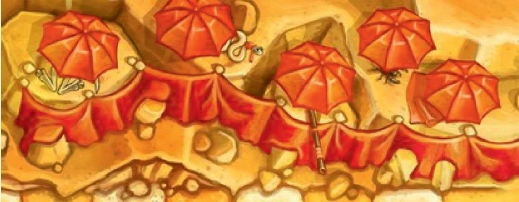
Example: Fan block for red.
As soon as a kangaroo has crossed the start-finish line again after
a complete circuit of the "Billabong" - that means, lands on a space
behind this line after a legitimate move - it is placed in
its fan block (see illustration).
Note that in particular, a kangaroo can hop around as much as it likes/can - if it makes a complete clockwise circle, then the finish has been reached.
The first player to get all five kangaroos of their team across the finish line wins.
At Yucata there isn't only one single winner but all players are assigned a ranking:
The more kangaroos a player could bring across the finish line, the higher their rank.
If two players could bring the same number of kangaroos across the finish line, the player who had that number of kangaroos over the finish line first, gets the higher rank.
This is indicated by gold, silver and bronze medals on the kangaroos:

Play Variants
"Kangaroo selection can be undone"
This allows the players to undo the selection of a kangaroo for movement in order to move another kangaroo. This makes it possible to try out which kangaroo can jump where.
Reminder: According to the standard rules (that is without this play variant) you may not undo the selection. Instead, you have to move the kangaroo you selected first. (However, the movements of the kangaroo can still be undone.)
"Sleeping kangaroos" (for 2-3 players, not for 4 players)
At the beginning of the game, the kangaroos of a different colour
are randomly distributed on the game board.
These kangaroos do not move, but can be jumped over.
All other rules remain the same.
"Continue Play" (for 3-4 players, not for 2 players)
After the first player has got all his kangaroos over the finish line, the remaining players keep on playing until only one player has kangaroos in play that have not yet crossed the finish line.
The players' rank then corresponds to the order they got their kangaroos over the finish line.
Reminder: According to the standard rules (that is without this play variant) the game ends immediately after one player has brought all 5 of his kangaroos across the finish line.
"Quickstart"
This variant accelerates the placement of the kangaroos at the start of the game.
One kangaroo of each player is automatically and randomly placed in each of the 4 quadrants behind the start-finish line (I-IV in the illustration below). Afterwards the players place their fifth kangaroo on one of the remaining free spaces behind the start-finish line (see the area marked in dark green in the illustration below). The game then continues according to the standard rules.
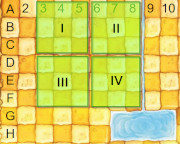

-
You can activate the color blind help in the game settings.
-
To distinguish the kangaroos that have not yet crossed the starting line from those that are already "in the race", those yet to start are indicated with a tail
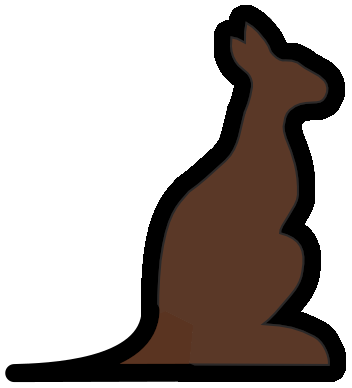 , those already racing, without
, those already racing, without
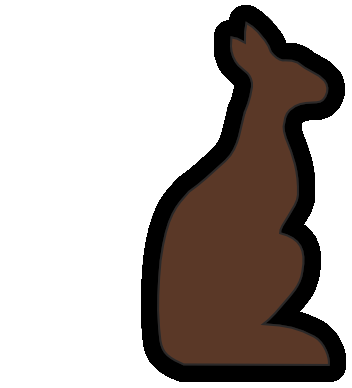 . Additionally, a kangaroo that has not yet crossed the starting line is indicated with a stopwatch
. Additionally, a kangaroo that has not yet crossed the starting line is indicated with a stopwatch  next to it.
To also make them easier to distinguish, the play variant Sleeping Kangaroos shows the sleepers with tails and with a speech bubble with "💤". next to it.
To also make them easier to distinguish, the play variant Sleeping Kangaroos shows the sleepers with tails and with a speech bubble with "💤".
-
As it is important for the game decisions, the game variants Kangaroo selection can be undone and Continue Play are clearly displayed in the header of the game window.
-
Hovering with your mouse over the foot symbol in one of the player info areas will show the last move of the corresponding player.
-
Hovering with your mouse over a coordinate in the game log will highlight the field with that coordinate on the board. In addition, the kangaroo's movement in the respective turn up to that space is shown.
-
Animations can be disabled via the game settings.
-
Board coordinates can be displayed permanently via the game settings.
| |